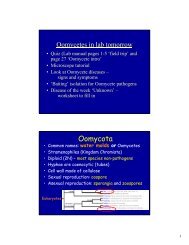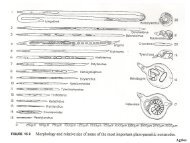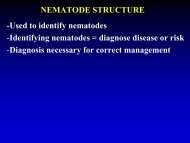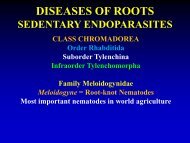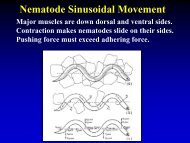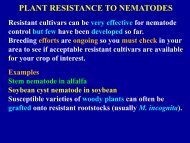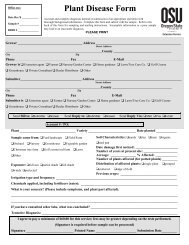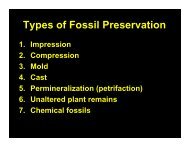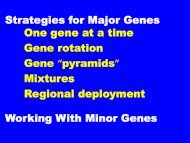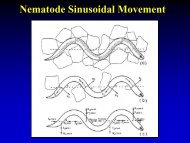DISEASES OF ROOTS MIGRATORY ECTOPARASITES
DISEASES OF ROOTS MIGRATORY ECTOPARASITES
DISEASES OF ROOTS MIGRATORY ECTOPARASITES
You also want an ePaper? Increase the reach of your titles
YUMPU automatically turns print PDFs into web optimized ePapers that Google loves.
<strong>DISEASES</strong> <strong>OF</strong> <strong>ROOTS</strong><br />
SEDENTARY <strong>ECTOPARASITES</strong><br />
CLASS CHROMADOREA<br />
Order Rhabditida<br />
Suborder Tylenchina<br />
Infraorder Tylenchomorpha<br />
Family Tylenchulidae<br />
Tylenchulus<br />
Tylenchulus semipenetrans = Citrus Nematode<br />
= major citrus pathogen throughout the world<br />
Causes “Slow Decline”<br />
Also important on grape, olive, persimmon
*<br />
Agrios
Tylenchulus semipenetrans = citrus nematode<br />
2.<br />
Nematode molts<br />
3 times to become<br />
an adult<br />
3.<br />
Posterior remains<br />
in soil and female<br />
swells with eggs<br />
1.<br />
J2 infective<br />
penetrate outer<br />
layers of cortex<br />
Van Gundy & Kirkpatrick
Tylenchulus semipenetrans – Citrus Nematode<br />
Anterior elongates, penetrates deep into cortex,<br />
becomes irregularly shaped and fills shape of cells<br />
R.S. Hussey<br />
Nemapix 1<br />
J.D. Eisenback<br />
Nemapix 1
Tylenchulus semipenetrans – Citrus Nematode<br />
Female feeds and destroys<br />
cells, leaving space for<br />
head to move around<br />
6-10 nurse cells form<br />
in cortex, do not enlarge<br />
APS Slide Set #20
Tylenchulus semipenetrans – Citrus Nematode<br />
Males remain motile in soil to<br />
mate with females but males<br />
are not required for<br />
reproduction.<br />
Some males reportedly do not<br />
feed either as juveniles or as<br />
adults and have reduced<br />
stylet and esophagus.<br />
Nemaplex<br />
U.C. Davis<br />
Nematology
Tylenchulus semipenetrans – Citrus Nematode<br />
Eggs are deposited in a gelatinous matrix in the soil.<br />
Life cycle is completed in 9 weeks.<br />
Feeder roots look encrusted due to<br />
sand embedded in gelatinous matrix<br />
(= sign not symptom).<br />
U.C. Nematology<br />
Nemapix 2
Tylenchulus semipenetrans – Citrus Nematode<br />
Development of J2 stops if host is not present.<br />
J2 can persist in soil for years<br />
until host is present.<br />
Nemaplex<br />
U.C. Davis<br />
Nematology
Tylenchulus semipenetrans – Citrus Nematode<br />
Symptoms of “Slow Decline”<br />
- Tissue damage per individual is not great.<br />
- Problem is with high populations<br />
(500+/g soil and roots = 100+/cm root length)<br />
- Small feeder roots do not develop properly which<br />
causes slow decline.<br />
- Plants can't get enough nutrients or water.<br />
- Nurse cells eventually break down and allow<br />
microorganisms to invade = increased necrosis.
Tylenchulus semipenetrans – Citrus Nematode<br />
“Slow Decline”<br />
J.W. Noling
Tylenchulus semipenetrans – Citrus Nematode<br />
Symptoms of “Slow Decline”<br />
Foliage sparse, often dull gray-green or bronze-green,<br />
leaves smaller than normal, upright and cupped.<br />
New growth is reduced.<br />
Fruit set reduced,<br />
smaller than normal.<br />
Trees wilt often<br />
during midday.<br />
C. Overstreet<br />
Nemapix 1
http://www.plantprotection.hu/modulok/angol/citrus/citrus_images/
Tylenchulus semipenetrans – Citrus Nematode<br />
Symptoms of “Slow Decline”<br />
- Disease is severely influenced by soil and nutrient<br />
conditions.<br />
- Soils with 10-15% clay are worse (?) than those with<br />
either more or less clay.<br />
=> sandy soils favor the nematodes but damage is<br />
worse in soils that stay more wet.<br />
Nematodes do not do well in heavy soils.<br />
- Nematodes are more damaging when calcium, sodium,<br />
or potassium are in short supply.
Tylenchulus semipenetrans – Citrus Nematode<br />
Control<br />
- Sanitation to protect against introduction of<br />
nematode.<br />
- Hot water (45 C for 2 minutes) and nematicide dips<br />
of bare rooted seedlings.<br />
- Genetic resistance by grafting desirable varieties to<br />
resistant rootstocks.
Tylenchulus semipenetrans – Citrus Nematode<br />
Chemical control as a preplant treatment and/or in<br />
drenches of living trees.<br />
Periodic application through drip irrigation system.<br />
Untreated<br />
Nematicide treated<br />
Treatments have resulted in 5X increases in yield.
<strong>DISEASES</strong> <strong>OF</strong> <strong>ROOTS</strong><br />
SEDENTARY <strong>ECTOPARASITES</strong><br />
CLASS CHROMADOREA<br />
Order Rhabditida<br />
Suborder Tylenchina<br />
Infraorder Tylenchomorpha<br />
Family Hoplolaimidae<br />
Rotylenchulus<br />
Rotylenchulus reniformis = Reniform Nematode<br />
Important to many crops in warm climates.<br />
Cotton, tomato, soybean, sweet potato, pineapple, etc.
*<br />
Agrios
Rotylenchulus reniformis – Reniform Nematode<br />
Young female is infective.<br />
Penetrates anywhere<br />
on root<br />
Stimulus from root<br />
needed for final molt<br />
Head pushes<br />
through to<br />
endodermal<br />
cells<br />
J2 molt 3 times<br />
without feeding,<br />
into immature<br />
males and females<br />
C. Overstreet
Rotylenchulus reniformis – Reniform Nematode<br />
J2 molt 3 times without<br />
feeding, develop into<br />
immature males and females.<br />
Young females are infective<br />
stage, males remain in soil.<br />
E.C. McGawley<br />
Nemapix 1
Rotylenchulus reniformis – Reniform Nematode<br />
Nematode pushes through<br />
cortex cells until its head<br />
rests in endodermal cell.<br />
R.S. Hussey<br />
Nemapix 1
Rotylenchulus reniformis – Reniform Nematode<br />
Female becomes sedentary and the feeding site develops into a<br />
syncytium of 5-10 interconnected, and usually enlarged pericycle<br />
cells.<br />
R.V. Rebois<br />
Nemapix 1
Rotylenchulus reniformis – Reniform Nematode<br />
Life cycle is completed<br />
in 3-4 weeks.<br />
Populations may reach<br />
10,000/100 cc soil!<br />
Kidney-shaped reniform nematode<br />
U. Zunke<br />
Nemapix 2
Rotylenchulus reniformis – Reniform Nematode<br />
C. Overstreet<br />
Nemapix 1<br />
Females lay eggs into large<br />
gelatinous matrix.<br />
Sand grains adhere to<br />
Matrix and serve as a sign<br />
of infection.
Rotylenchulus reniformis – Reniform Nematode<br />
Symptoms<br />
- Infected plants have reduced levels of nitrogen,<br />
potassium, and manganese and exhibit these nutrient<br />
deficiencies.<br />
- Inadequate root function due to root damage results<br />
in leaf tissues with compact, small cells.<br />
- Smaller leaves reflect less light than healthy leaves<br />
and allows for large areas to be assessed for damage<br />
with remote sensing.
Rotylenchulus reniformis – Reniform Nematode<br />
Feeding damage to banana rhizomes<br />
Sambasivam
Rotylenchulus reniformis – Reniform Nematode<br />
Six Untreated Rows of Cotton<br />
C. Overstreet<br />
Nemapix 1
Rotylenchulus reniformis – Reniform Nematode<br />
Symptoms – Pineapple<br />
E.C. McGawley<br />
Nemapix 1
Rotylenchulus reniformis – Reniform Nematode<br />
Control<br />
- Resistant varieties of soybean have been developed.<br />
- Some legumes, grasses and sugarcane do not support<br />
reproduction and can be used in crop rotation.<br />
- Chemical nematicides



